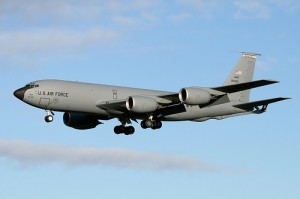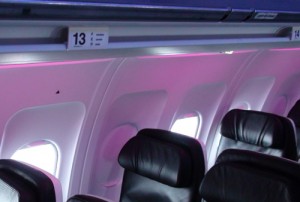
Virgin America has a 13th Row, I even sat in it and it was ok. Photo from AirlineReporter.com
Happy Friday the 13th everyone! While you are watching out for black cats and ladders today, you might want to avoid sitting in row 13. Some airlines make it easier for you to avoid.
Many years ago I would fly Reno Air quite a bit between Seattle, WA and Reno, NV (it was bought by American Airlines in 1999). During one of my flights I was in row 14. As normal I walked down the aisle counting up to find my seat: 10, 11, 12, 14. Where was row 13? I ended up asking a flight attendant and she stated it was a sign of bad luck and they didn’t want any of their passengers to feel unlucky before going to Reno. This made sense; the airline made their business off a city based on luck and they wouldn’t want anyone to perceive any bad luck on one of their flights.
More recently, when I flew on AirTran for their wi-fi announcement, I noticed they also didn’t have a 13th row. It got me thinking, are there that many superstitious travelers afraid of the number 13? I decided to push my luck and find out why some airlines do not have a 13th row.
Using my own experience, talking with people from the airlines, and using SeatGuru.com I found these airlines do NOT have a 13th row: AirFrance, Iberia, Ryanair, AirTran, Continental, Air New Zealand, Lufthansa, and Alaska Airlines (but only on their Boeing 737-800’s).
I first spoke with Jennifer Janzen, Corporate Communications Manager with Lufthansa airlines and she explained to me that they also do not have a 17th row. Janzen informed me, “On board Lufthansa aircraft correspondingly the twelfth row is followed by the 14th. The attentive passenger, however, will also notice the absence of row 17. The reason is that in Italy and Brazil, 17 is regarded as unlucky.” On the other side, she pointed out that Lufthansa will use “Gate 13” and has a flight number LF-013 that leaves Hamburg bound for Frankfurt daily.
USA Today asked Continental about the 13th row in 2005 and they stated, “Apparently someone a long time ago (we don’t know when) thought we shouldn’t have a row 13. We have let the row numbering system persist, especially since we don’t want to go through the expense of renumbering rows on about 600 aircraft.”
Judy Graham-Weaver, a spokesperson for AirTran told USA Today, “Most people wouldn’t want to sit there. Whether we believe in the superstition or not if it’s the perception of the community we need to go by that.”
Of course this makes sense. There are a lot of passengers who fear flying and the number “13” doesn’t have the most positive thoughts attached to it. This explains why airlines have their entire fleets with or without a 13th row, but I wondered, why did Alaska Airlines have a 13th row in all planes except their Boeing 737-800’s?
Geoff Pettis, Manager of Interior Engineering with Alaska Airlines, cleared up my confusion by telling me the Boeing 737-800’s were not originally supposed to be their planes. “Alaska Airlines was already operating the 737-700 and 737-900 when the decision was made to start operating the 737-800s. Due to cancellations by other airlines, Alaska was able to practically buy the first couple right off the assembly line. However, this compressed time frame meant Alaska was not able to spec out [design] the cabin as would have normally happened.” To keep the layout consistent, they continued to order new 800’s without a 13th row, “but not because of any superstition.”
I also wanted to get an opinion from a seat expert or a seat guru, if you will. I spoke with Matt Daimler, Founder of Seatguru.com on what he thinks about the 13th row. “I believe the goal of airlines omitting it is to help reduce anxiety that flyers may have.” He did tell me he has two concerns with the 13th row. First, “The row that would have been marked 13 is rarely actually the 13th row of seats on the plane. This is because the airlines typically skip numbering as they move from First Class to Coach.” His second issue was, “The airlines that omit row 13 have flight numbers such as 113 and 213, which seem equally unlucky to me.” Daimler says he has no problem flying in the 13th row, “unless SeatGuru says it’s a red seat [bad seat to sit in] of course!.”
A simple question led to some interesting answers. Do any of you fear riding in the 13th row of an airplane? How about flying on Friday the 13th or from Gate 13?
follow via | web | twitter | email | rss |
One of the great things about living in the Pacific Northwest is its connection to aviation. Just about 10 miles north of where I live, is the Future of Flight (FoF), which is right next to Paine Field in Everett. The FoF was opened in December 2005 with collaboration between The Boeing Company, Future of Flight Foundation, Snohomish County Public Facilities District and the Snohomish County Airport(Paine Field) with the idea of showcasing the future of commercial aviation. Even though Boeing is a supporter and offers their Boeing tour from the same location, the FoF does not limit their displays to only Boeing products, but shares the history, present, and future of all commercial aviation brands. The $23million project attracts about 175,000 visitors from 175 different countries every year. This was all too tempting to pass up and I was invited to check out what they have to offer first hand.
When I arrived, I was greeted by Sandy Ward, Marketing Director, and Ed Kaplania, Projects Manager (and aviation genius). For about the next hour and a half, they would be my tour guides showing me all the wonders of the FoF. The first thing I noticed was they had a Beechcraft Starship hanging on their ceiling; it was then, I knew I was going to fall in love with this place.
My favorite part of the visit was the cockpit of a Boeing 727-200. The plane was donated by>>>. I was amazed with all the switches, buttons, lights, and fuses. I probably sat in the cockpit for 30 minutes. I felt like a 12 year old kid, having to flip all the switches and getting satisfaction from the tactile feel of each switch’s throw. Outside of the cockpit there is a virtual tour of the new Boeing 787 “glass cockpit” What a stark difference! The FoF plans to add a physical “glass cockpit” to put next to the 727’s so visitors can see first hand the vast difference. Although the newer cockpits are much more advanced, need only two (well really one) people, and have far fewer switches, there seems to be some connection lost between the pilot and plane.
Around the main floor there are computer monitors where visitors can design their own aircraft. They can choose fuselage size, wing size, materials, etc. As you change each option , the program tells you how many miles the plane will fly, the passenger load, the fuel efficiency, etc. I was quite entertained trying the different options and it took me a while to realize I was actually learning things about how the design affected the stats of the aircraft. I was very happy with my end result (Can hold 451 people in a 2-class layout and go 18,000 miles — which I know any plane that can go over 12,000 miles is pretty useless, but whatever, it looks awesome). After you are happy with your design, you are able to print off a copy in the gift shop for free.
There are a few high tech and static displays that allow you to explore the workings of a jet engine. One is able to explore the difference between the rivet/panel approach to the old Boeing 707, versus the smooth, single panel approach to composite materials. There is a mock up of the interior of the new Boeing 787, as well as one from a 767. You can spend a few hours reading about the histories of all the commercial jets, which is almost what I did.
Then to top it off, there is a roof-top viewing area that overlooks Paine Field. To the left, one can see the hangars where all the magic happens. Straight ahead is a Dream Lifter that flies the Boeing 787 parts around the globe, and to the right are new planes (including the Boeing 787) ready to fly. They also have the traffic control on speakers, so you can hear what is going on. Unfortunately it was rainy, cold, windy, and getting dark, so I wasn’t able to stick around long enough to catch a glimpse of a takeoff. When it is clear out, one can see the Cascade Mountains, Mount Rainier, and Mount Baker while watching airplanes taking off and landing. Yes folks, this is pretty much aviation nerd heaven (only if they had a cafe up there).
For those who like aviation shopping, have no fear — there are two options. First you have the Future of Flight gift shop, with some aviation and northwest themed items, but you also have the Boeing gift shop, where I could easy spend a few grand without thinking. I contemplated not going into either (to stop the temptation of spending money), but how could I refuse? Luckily I walked out with only one model of a Alaska Airlines Boeing 737; it took a lot of will power.
If you like aviation and you are in the Seattle area, you need to check out the Future of Flight. It is a growing collection with many new exciting features planned. Guests also have the ability to take the Boeing Tourhttp://www.futureofflight.org/planavisit.html#BoeingTourInformation, which I hope to return and take soon. Don’t worry, when I do, I will be sure to let you know how it goes!
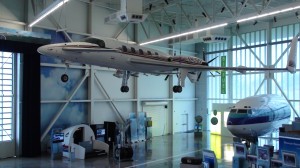
The main area of the Future of Flight. Up is the Starship, to the right, the front end of a B727, on the bottom, a B727 cockpit.
One of the great things about living in the Pacific Northwest is its connection to aviation. Just about 10 miles north of where I live, is the Future of Flight (FoF), which is right next to Paine Field in Everett. The FoF was opened in December 2005 with collaboration between The Boeing Company, Future of Flight Foundation, Snohomish County Public Facilities District and the Snohomish County Airport (Paine Field) with the idea of showcasing the future of commercial aviation. Even though Boeing is a supporter and offers their Boeing tour from the same location, the FoF does not limit their displays to only Boeing products, but shares the past, present, and future of all commercial aviation brands. The $23 million project attracts about 175,000 visitors from 175 different countries every year. This was all too tempting to pass up and I was invited to check out what they have to offer first hand.
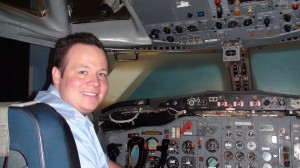
The Airline Reporter himself inside the cockpit of the Boeing 727 with all the buttons and lights.
When I arrived, I was greeted by Sandy Ward, Marketing Director, and Ed Kaplania, Projects Manager (and aviation genius). For about the next hour and a half, they would be my tour guides showing me all the wonders of the FoF. The first thing I noticed was they had a Beechcraft Starship hanging on their ceiling; it was then, I knew I was going to fall in love with this place.
My favorite part of the visit was the cockpit of a Boeing 727-200. I was amazed with all the switches, buttons, lights, and fuses. I probably sat in the cockpit for 30 minutes. I felt like a 12 year old kid, having to flip all the switches and getting satisfaction from the tactile feel of each switch’s throw. Outside of the cockpit there is a virtual tour of the new Boeing 787 “glass cockpit” What a stark difference! The FoF plans to add a physical “glass cockpit” to put next to the 727’s so visitors can see first hand the vast difference. Although the newer cockpits are much more advanced, need only two (well really one) people, and have far fewer switches, there seems to be some connection lost between the pilot and plane.
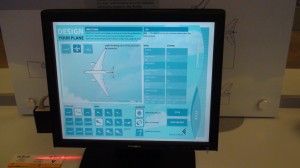
Use computers around the FoF to build your own airliner. The program told me the wings were too small on this one, but I didn't care.
Around the main floor there are computer monitors where visitors can design their own aircraft (see pic to the left). They can choose fuselage size, wing size, materials, etc. As you change each option, the program tells you how many miles the plane will fly, the passenger load, the fuel efficiency, etc. I was quite entertained trying the different options and it took me a while to realize I was actually learning things about how the design affected the stats of the aircraft. I was very happy with my end result (can hold 451 people in a 2-class layout and go almost 19,000 miles — which I know any plane that can go over 12,000 miles is pretty useless, but whatever, it looks awesome). After you are happy with your design, you are able to print off a copy in the gift shop for free.
There are a few high tech and static displays that allow you to explore the workings of a jet engine (I got to climb into one, kind of scary). One is able to explore the difference between the rivet/panel approach to the old Boeing 707, versus the smooth, single panel approach to composite materials. There is a mock up of the interior of the new Boeing 787, as well as one from a 767. You can spend a few hours reading about the histories of all the commercial jets, which is almost what I did.
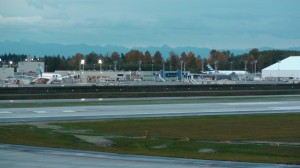
Yes, you can see two Boeing 787's from this view.
Then to top it off, there is a roof-top viewing area that overlooks Paine Field. To the left, one can see the hangars where all the magic happens. Straight ahead is a Dream Lifter that flies the Boeing 787 parts around the globe, and to the right are new planes (including the Boeing 787) ready to fly. They also have the traffic control on speakers, so you can hear what is going on. Unfortunately it was rainy, cold, windy, and getting dark, so I wasn’t able to stick around long enough to catch a glimpse of a takeoff. When it is clear out, one can see the Cascade Mountains, Mount Rainier, and Mount Baker while watching airplanes taking off and landing. Yes folks, this is pretty much aviation nerd heaven (only if they had a cafe up there).
For those who like aviation shopping, have no fear — there are two options: first you have the Future of Flight gift shop, with some aviation and northwest themed items, but you also have the Boeing gift shop, where I could easily spend a few grand without thinking. I contemplated not going into either (to stop the temptation of spending money), but how could I refuse? Luckily I walked out with only one model of a Alaska Airlines Boeing 737; it took a lot of will power.
If you like aviation and you are in the Seattle area, you need to check out the Future of Flight. It is a growing collection with many new exciting features planned. Guests also have the ability to take the Boeing Tour, which I hope to return and take soon. Don’t worry, when I do, I will be sure to let you know how it goes!
SEE THE REST OF THE PICTURES HERE.
follow via | web | twitter | email | rss |
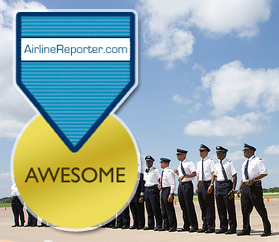
Congratulations pilots! You win the first ever AirlineReporter.com AWESOME Medal!
Commercial airline pilots haven’t been getting good press recently. I am reading a lot in the “mainstream” media about how this is an epidemic and how pilots are now so unprofessional. Most of these folks like big headlines, but offer little content or support.
Sure, they do have some valid material to work with. We have the Qantas pilots who forgot the landing gear, we have the pilot asking passengers to pray, we have the pilots who overshot an airport, and most recently a United Airlines pilot got arrested for being too drunk.
Yes, all these incidents are not professional, inappropriate, and dangerous. These pilots should be dealt with appropriately. But this is NOT an epidemic, this is not going to be an on-going trend, and most importantly these actions do not represent the huge majority of pilots out flying today.
Pilots don’t always have it easy. With pay cuts, increased hours, time away from family, it can be a difficult job. But most pilots are not doing it for the free airline tickets or a fancy pilot’s hat. They do it because they have a passion for flying and absolutely love their jobs.
On any given day in the United States there are about 87,000 flights. About 30,000 of which are commercial airline flights. Those are a lot of flights flown by professional pilots who safely get their passengers, cargo, and themselves to their destination safely each and everyday.
I just want people to be aware and do not discriminate against a whole profession, just from a few bad apples!
So, to celebrate the 99.9% of wonderful pilots out there, I give my first ever AirlineReporter.com AWESOME medal to all those great pilots out there, who help to make an airline industry exciting!
follow via | web | twitter | email | rss |
Image: Orig from American Airlines
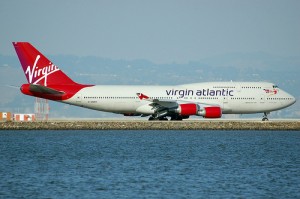
Virgin Atlantic "Tubular Belle" Boeing 747-400 that is taxiing (get it?)
Have you ever flown into a large city, had to grab a taxi downtown and thought, “man there have to be other people doing the same thing? I wish I could save a few bucks and share a cab.” Maybe you had the guts to ask people around you where they were going, but for those of us who don’t, you now have another option.
Virgin Atlantic working with NESTA (UK endowment to support innovation) is helping to test a program to help passengers share a Taxi. Called Taxi2, passengers can sign up on their website, input their flight details, they are then sent information on a probable match and can choose to accept or reject the match. The site will let you pick the sex of your passenger (presumably for safety female passengers, not to set up a date) and the program is not limited to just Virgin Atlantic customers.
Ed Maklouf, founder of Taxi2, said, “We are delighted to be partnering with Virgin Atlantic for this scheme, and our expectation is that this simple, sensible way of saving money and cutting down congestion and carbon footprint will become common activity for air travelers worldwide.”
You are even able to print off your own mini-sign (called “Clever-Ticket”) to help meeting up with your new taxi-friend.
The website isn’t clear where passengers can use the service. I asked Virgin Atlantic and they said, “Since the service is in beta for the first few months we developed it for the London to NY routes initially, however passengers traveling to any of our gateways can utilize the program.” It might be limited now, but hopefully it takes off (heh) and will spread to other locations worldwide. Passengers can get the speed and convenience of a taxi, but the cost of an airport shuttle.
follow via | web | twitter | email | rss |
Image: Rich Snyder





